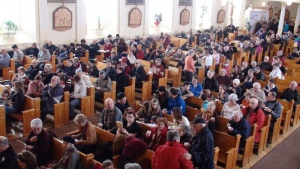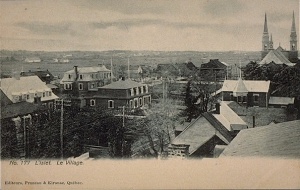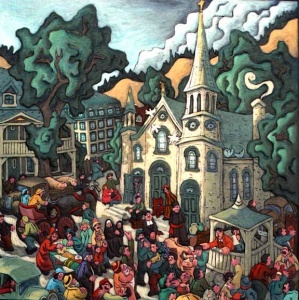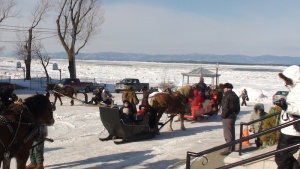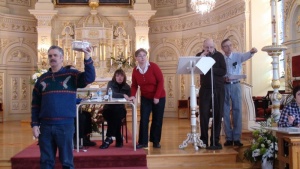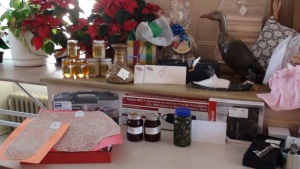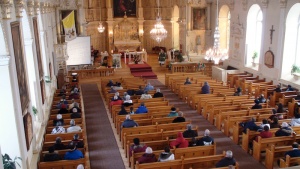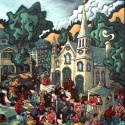The Criée des Âmes in L’Islet-sur-Mer
par Couvrette, Sébastien
A custom dating back to the French Regime, the Criée des Âmes, or “All Souls Auction,” is a practice rooted in both religious and folk traditions. Originally, proceeds from these auctions were used to pay for masses to free souls from purgatory. Nowadays, the event is an original fundraising activity that helps Quebec parishes pay for church maintenance. A Criée des Âmes has been held every year since 1980 in L’Islet-sur-Mer, a town in Quebec’s Chaudière-Appalaches region. The ceremony also provides a special opportunity to revive time-honoured local cultural traditions, like berlot sleigh rides, sleigh drivers dressed in capots de chat (raccoon coats), and bowls of chiard blanc, a favourite local dish.
Article disponible en français : Criée des âmes à l’Islet-sur-Mer
Celebrating the Past
In the wintertime, visitors to the L’Islet-sur-Mer district of the municipality of L’Islet located along the St. Lawrence River 100 kilometres east of Quebec City, have a rare opportunity to witness a sleigh parade and, more importantly, an old religious tradition known as the Criée des Âmes, or “All Souls Auction.” Every year in February, the Notre-Dame-de-Bonsecours parish council holds a day of fundraising to help maintain and preserve its religious heritage. The day features two important events commemorating the deep-rooted traditions and history of L’Islet-sur-Mer: the Criée and the parade of the berlots, a type of sleigh.
An Old French Tradition
The Criée des Âmes is an old French custom that normally took place every Sunday in November, the month that Catholics devote to prayer for the departed. After mass, a crier would stand atop a platform set up on the steps outside the church to announce the auction of handicrafts and farm products donated by parishioners. The funds raised were used to pay for masses to release souls from purgatory so they could enter heaven. This tradition crossed the Atlantic with French settlers and was so firmly rooted under the French Regime that it was celebrated in most parishes across Quebec.
Despite its popularity, the Criée was gradually abandoned in the 18th and 19th centuries, but it was never completely forgotten. The tradition lived on in certain places such as Isle-aux-Grues where it is held every Sunday in January, a part of local culture since 1836. Taking a page from Quebec ethnologist and folklorist Marius Barbeau, illustrators Edmond-Joseph Massicotte and Henri Julien, and writer Adjutor Rivard helped keep the Criée tradition alive in the collective memory during the first quarter of the 20th century (NOTE 1). Since then, many parishes have revived this time-honoured celebration. It is one of the oldest French religious traditions still practiced today.
In L’Islet-sur-Mer, the Criée des Âmes was resurrected for the first time in the summer of 1977 during the tricentennial celebrations of the foundation of the Seigniory of L’Islet-St-Jean (NOTE 2). L’Islet-sur-Mer residents relived a piece of their heritage by auctioning off farm animals at the Criée just as their ancestors once did. Starting in 1980, the Notre-Dame-de-Bonsecours parish council introduced a yearly carnival to raise funds. Capitalizing on the success of the event held three years earlier, the organizers added the colourful Criée and the berlot parade to carnival activities like a lumberjack competition, snowmobile races, and other attractions. The carnival activities were gradually abandoned in the 1990s, and today the old religious traditions are all that remain.
The Berlot Parade
Held on a Sunday in February, the L’Islet-sur-Mer Criée des Âmes is preceded by a morning parade of berlots. The term berlot refers to a particular type of horse-drawn winter sleigh invented in Quebec in the late 19th century. This typical Quebec heritage creation was spawned out of successive improvements to the rudimentary sleighs used to transport wood in the mid-17th century (NOTE 3).
Event organizers first came up with the idea of holding a berlot parade in L’Islet-sur-Mer as a way to recreate the memories of their childhood. They wanted younger generations to get a taste of the not-so-distant past (the 1940s and 1950s), when the people of the neighbouring village of Trois-Saumons would travel by horse-drawn sleigh to attend mass at the Notre-Dame-de-Bonsecours Church. The parade was so popular that it has become an important fixture on the annual event calendar. In the spirit of the carnival celebrations and traditions of yesteryear, sleigh drivers are encouraged to don their raccoon coats for the event. Like the arrowhead sash, such coats—originally made of raccoon fur—are an iconic part of French Canadian fashion heritage. They were part of the folk costumes frequently worn at winter carnivals, particularly by elected officials (NOTE 4).
Every year, some 30 sleighs take part in the berlot parade. The four-kilometre parade route starts near the village of Trois-Saumons and ends by the river at the Notre-Dame-de-Bonsecours Church, where Sunday mass is celebrated. Classified a historic monument, this church built in the 1770s provides the perfect heritage backdrop for this venerable celebration. The berlot parade showcases the wide variety of horse-drawn sleighs typical of Quebec’s material culture as well as the old skills of harnessing and sleigh driving.
Criée des Âmes
The Criée des Âmes auction is held after the mass that follows the berlot parade. Breaking with tradition, today’s auctions are not held on the church steps, but rather inside—sheltered from the glacial February winds. Participants are invited to warm up and have a hot meal of baked beans and chiard blanc, a hearty local specialty. This typical eastern Quebec dish, a mixture of potato and onions cooked in salt pork fat, has a number of different names depending on the region: patates fricassées in Saguenay, patates à Bernard in the Lower St. Lawrence, and chiard de goélette in the Gaspé and Magdalen Islands (NOTE 5). In L’Islet, chiard blanc became a veritable emblem of local culinary heritage—to such an extent that toward the end of the 19th century, locals were nicknamed “Chiards-Blancs” because of their love for the dish (NOTE 6).
Before the auction, the parish churchwardens collect and take inventory of the goods donated by parishioners. Homemade pies, jams, breads, and cakes line up enticingly next to farm products and handicrafts such as wood sculptures, cushions, placemats, and blankets. Standing in the church choir, the crier presents all the goods up for auction and sets the opening bids. As custom has it, parishioners, their generosity spurred on by the crier’s encouragements, purchase most items at prices higher than their real monetary value. In fact, certain perpetual favourites are highly sought after and can bring in a pretty penny. Every year over 250 people attend the auction, and their participation helps the church raise thousands of dollars.
Replenishing Parish Coffers and Celebrating Local Identity
The Criée des Âmes lives on in certain regions of Quebec, allowing parishes to partially offset the decline in revenues caused by dwindling church attendance. In L’Islet-sur-Mer, the Criée has helped revive traditional community life by showcasing time-honoured facets of local cultural identity such as berlot rides, traditional raccoon coats, and the local culinary specialty known as chiard blanc. By organizing activities to help maintain and preserve the church, the Notre-Dame-de-Bonsecours parish council also helps transmit and preserve the region’s rich intangible heritage and clothing and culinary traditions.
Sébastien Couvrette
Historian, Université Laval
NOTES
1. David Karel, Edmond-Joseph Massicotte, illustrateur, Quebec, Musée national des beaux-arts du Québec, 2005. Adjutor Rivard, Chez nos gens, Quebec, L’Action sociale catholique, 1918, pp. 85–93.
2. In 1677 Governor Frontenac also conceded the Seigniory of Bonsecours, which is currently part of the municipal territory of L’Islet.
3. Paul-André Leclerc, “Promenades d’hiver : traînes, berlines, carrioles, sleighs...,” Cap-aux-Diamants : la revue d’histoire du Québec, no. 24 (1991), pp. 42–45.
4. Jocelyne Mathieu, “Costumes et déguisements de carnaval,” Cap-aux-Diamants : la revue d’histoire du Québec, vol. 4, no. 2 (1988), p. 41–44.
5. Hélène Matteau, “Des mots savoureux,” Cap-aux-Diamants : la revue d’histoire du Québec, no. 44 (1996), pp. 36–39.
6. Marcel Rioux, “Le blason populaire canadien,” Le Canada français, vol. 32, no. 4 (1944), p. 263.
Bibliography
Beaudin, Dominique, « La criée pour les âmes », L’Action nationale, vol. 4 (1934), p. 185-188.
Karel, David, Edmond-Joseph Massicotte, illustrateur, Québec, Musée national des beaux-arts du Québec, 2005.
Leboeuf, Francine, Échos d’antan, Montréal, Éditions Paulines, 1991.
Leclerc, Paul-André, « Promenades d’hiver : traînes, berlines, carrioles, sleighs... », Cap-aux-Diamants : la revue d’histoire du Québec, no 24 (1991), p. 42-45.
Massicotte, Édouard-Zotique, « La criée pour les âmes au Canada et en France », Bulletin des recherches historiques, vol. 34, no 12, 1928, p. 712-713.
Mathieu, Jocelyne, « Costumes et déguisements de carnaval », Cap-aux-Diamants : la revue d’histoire du Québec, vol. 4, no 2 (1988), p. 41-44.
Matteau, Hélène, « Des mots savoureux », Cap-aux-Diamants : la revue d’histoire du Québec, no 44 (1996), p. 36-39.
Provencher, Jean, Les quatre saisons dans la vallée du Saint-Laurent, Montréal, Boréal, 1988.
Rioux, Marcel, « Le blason populaire canadien », Le Canada français, vol. 32, no 4 (1944), p. 259-265.
Rivard, Adjutor, Chez nos gens, Québec, L’Action sociale catholique, 1918.
Saint-Pierre, Louise, 6 février 2011, Entrevue avec Marguerite Thibault, Jacqueline Caron Kirouac, Jeanine Caron Giasson, Conrad Caron et Jean-Marc Cloutier, responsables de la criée des âmes et de la parade des berlots, Inventaire du patrimoine immatériel religieux du Québec, L’Islet-sur-Mer, support numérique.
Séguin, Robert-Lionel « L’habitant et ses véhicules aux dix-sept et dix-huitième siècles », Revue d’histoire de l’Amérique française, vol. 11, n° 2 (1957), p. 242-269.
Documents
Adjutor Rivard, Chez nos gens, Québec, L’Action sociale catholique, 1918.
Additional DocumentsSome documents require an additional plugin to be consulted
Images
-
 Cheval attelé à un be
Cheval attelé à un be
rlot, L'Islet-s... -
 Criée des âmes à L’Is
Criée des âmes à L’Is
let-sur-Mer, fé... -
 Criée des âmes à L’Is
Criée des âmes à L’Is
let-sur-Mer, fé... -
 Départ des berlots ju
Départ des berlots ju
ste avant la cr...
-
 La criée évoque le mo
La criée évoque le mo
de de vie de ja... -
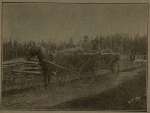 La criée évoque le mo
La criée évoque le mo
de de vie de ja... -
 La mise en encan à L’
La mise en encan à L’
Islet-sur-Mer, ... -
 Le «capot de chat» es
Le «capot de chat» es
t associé à l'h...
-
 Organisateurs de la c
Organisateurs de la c
riée des âmes à... -
 Parade des berlots ju
Parade des berlots ju
ste avant la cr... -
 Parade des berlots ju
Parade des berlots ju
ste avant la cr... -
 Parade des berlots ju
Parade des berlots ju
ste avant la cr...
-
 Parade des berlots ju
Parade des berlots ju
ste avant la cr... -
 Parade des berlots ju
Parade des berlots ju
ste avant la cr... -
 Participants à la cri
Participants à la cri
ée des âmes à L... -
 Préparatifs pour la c
Préparatifs pour la c
riée des âmes à...
-
 Préparation des produ
Préparation des produ
its offerts à l... -
 Quelques-uns des prod
Quelques-uns des prod
uits offerts à ... -
 Quelques-uns des prod
Quelques-uns des prod
uits offerts à ... -
 Rassemblement sur le
Rassemblement sur le
parvis de l'égl...
-
 Rue Principale, L'Isl
Rue Principale, L'Isl
et, P.Q. -
 Tarte mise à l'encan
Tarte mise à l'encan
pour la criée d... -
 Tarte mise à l'encan
Tarte mise à l'encan
pour la criée d... -
 Tarte mise à l'encan
Tarte mise à l'encan
pour la criée d...

